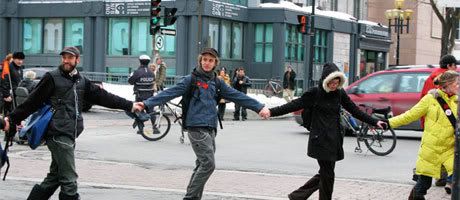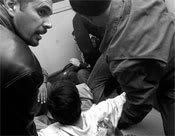News Roundup: 3/27/08

Québéc Students Defy Ban on Protests
Students at UQAM (which we have covered previously) are at it again — this time protesting a court-approved injunction against protests on UQAM campus. As UQAM finalizes its plan to cut educational services and raise tuition fees as a way to get itself onto better financial footing (instead of going to the legislature for more funding, which it should be doing), the administrators want to keep the rabble-rousing out of sight, by effectively outlawing the students right to strike. Well, that won't stop UQAM students (and faculty!). McGill Daily:The ban on student protests, which lasts until March 27th, was imposed by the UQAM administration the week before Tuesday’s protest and was approved by the Quebec Superior Court on March 18th.
It aims to prevent UQAM’s 14,000 striking students from disturbing the regular class schedule, or demonstrating within 100 metres of campus.
In response, students formed a human chain just outside of the 100-metre boundary. Any infringements on the injunction can result in a $50,000 fine.
“We’re going to respect the injunction within limits,” said Eve-Lyne Couturieu, communications officer for the striking political science and law students at UQAM.
“We’re also going to look for other means to proceed,” she added.
Strikes and demonstrations began breaking out at UQAM last semester, following the provincial government’s plan to lift the tuition freeze which had been in place since 1996.
The movement then shifted to focus on the University’s cost-cutting plans that aim to pull the university out of its $350 million debt.PriceWaterhouseCoopers, hired by UQAM to draft the plan, released its financial plan on March 5th. Among other measures, the report calls for increasing tuition fees, cutting 77 teaching positions and freezing employee salaries.
Thankfully this is the last day of the injunction, and if UQAM administrators don't extend it, students will once again be protesting on campus.
Fiji Students Fight Repressive University Regulations
Students at the University of the South Pacific are setting up a mass protest for later this week; the student association is demanding the resignation of Registrar Walter Fraser, who are in their eyes establishing and enforcing rules much too strictly on campus (the University administration, unsurprisingly, disagrees). The students gave Fraser two weeks to resign — that two weeks ended last Sunday. Pacific News Services:Students Association President, Ilifeleti Tobo told Pacnews that his members are 'unhappy with interferences from Mr Fraser on their on campus activities.'
"He has been very un-cooperative with us, blocking alot of our activities, thus the two weeks notice for him to step down.
"The letter was sent last week and the deadline will be this Sunday, 24 March." Tobo added.
He said if nothing favourable is received by the end of the deadline, 'students will protest.'
"For now, our membership plans to march to the USP Administration office to make our demands." Tobo claims the registrar has victimised the student body because the new executives refused to allow the use of students fund to pay for this year's orientation day programme.
"We've had clashes with the management after this decision. This was followed with stringent regulations imposed on students activities on campus."
A Tale of Two Sit-ins:
University of Toronto Students Harassed While York Students Left Alone
Interestingly enough, a recent sit-in protest at York University lasted over 24 hours, and actually won — students got the University President to sign onto a non-sweatshop pledge for all University clothing. Security personnel were there, but did not forcibly remove the students.A student sit-in at the University of Toronto’s (U of T) administrative offices last Thursday came to an abrupt halt after Toronto police and campus security physically intervened.
The protest, aimed at preventing a proposed 20 percent residence fee increase, took place inside Simcoe Hall, just outside U of T President David Naylor’s office. At one point, students convinced campus security to pass the president a note stating they “weren’t looking for trouble” and simply wanted a response. But within minutes, they were forcefully removed from the premises.
“We were there in the spirit of peaceful protest,” said Ryan Hayes, president of the U of T Arts and Science Students’ Union.
“But some people did get bruised, and some people did get their shirts ripped by police on that day.”
[...]
“The main issue is that the administration decided to use the police instead of talking to their students,” explained Hayes.
“You’re not going to touch anyone inside Simcoe Hall, the main administrative building, without first receiving orders from the administrators.”
“Why is it that when York held a peaceful demonstration, they were able to speak to their president, who eventually gave into their demands?” posited Hayes.
“We did the same thing – we just said ‘We’re here until we get a response.’ Ours was also a peaceful demonstration until the police escalated it.”
